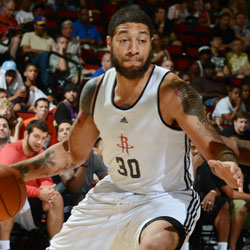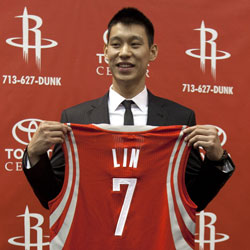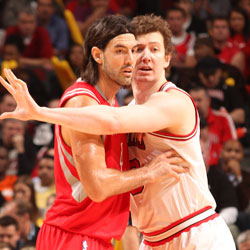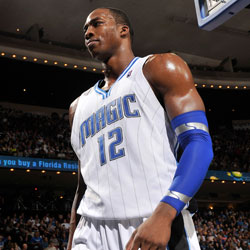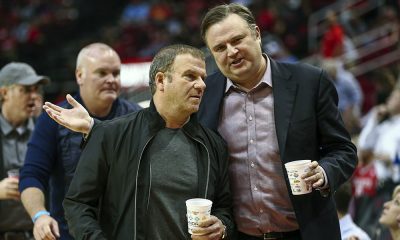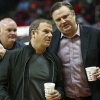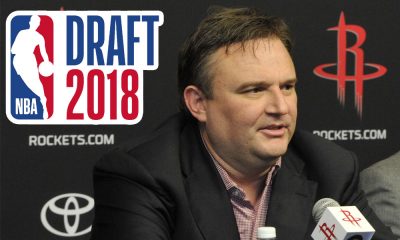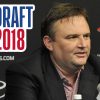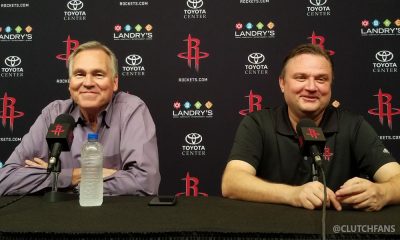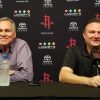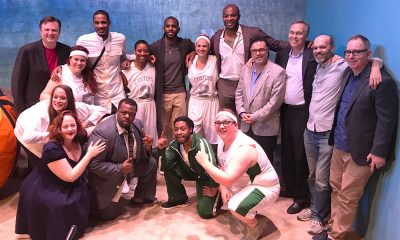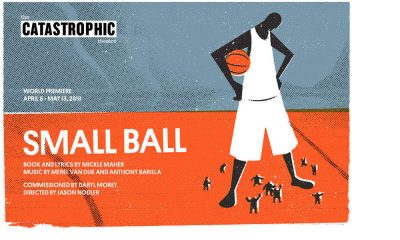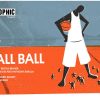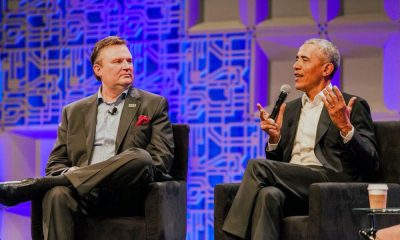Houston Rockets
Houston Rockets Salary Cap Update: “Total Rebuild” Edition
After closing the book on an all-too-brief 2011-12 NBA season and opening up the 2012 offseason with a flurry of activity, let’s take a look at the Houston Rockets’ current salary cap situation.
Published
12 years agoon
After closing the book on an all-too-brief 2011-12 NBA season and opening up the 2012 offseason with a flurry of activity, let’s take a look at the Houston Rockets’ current salary cap situation.
The Rockets’ Latest Moves
Since my last update, the Rockets have made the following roster moves:
- Prior to the end of the season, the Rockets signed Courtney Fortson and Diamon Simpson each to two-year deals for the league minimum, with team options on the second year with a non-guaranteed salary (the options were subsequently picked up).
- On June 26, the team traded Chase Budinger and the draft rights to Lior Eliyahu to the Minnesota Timberwolves in exchange for the #18 pick in the 2012 NBA Draft.
- On June 27, the Rockets traded the #14 pick in the 2012 NBA Draft, Samuel Dalembert, their 2014 second round pick and cash considerations to the Milwaukee Bucks in exchange for the #12 pick in the 2012 NBA Draft, Shaun Livingston, Jon Brockman and Jon Leuer.
- The Rockets selected Jeremy Lamb (#12), Royce White (#16) and Terrence Jones (#18) in the 2012 NBA Draft.
- The team purchased the draft rights to Turkish power forward Furkan Aldemir (the #53 pick in the 2012 NBA Draft) in a four-team trade involving the Los Angeles Clippers, the Dallas Mavericks and the Utah Jazz.
- During the July Moratorium, the team signed Donatas Motiejunas to his first round rookie scale contract at the maximum permitted 120% of his scale salary.
- On July 11, the Rockets traded Kyle Lowry to the Toronto Raptors in exchange for Gary Forbes and a future first rounder that is a likely lottery pick.
- Also on July 11, the team signed and traded Marcus Camby to the New York Knicks in exchange for Toney Douglas, the non-guaraneed contracts of Josh Harrellson and Jerome Jordan, and the Knicks’ second round picks in 2014 and 2015.
- On July 13, the Rockets waived Luis Scola via the amnesty provision, clearing his salary off of the team’s salary cap. (Scola was subsequently claimed off waivers by the Phoenix Suns with a partial claim bid; and the Suns will pay Scola approximately $4.5 million per season for each of the next three years, with the Rockets paying the rest of the $31 million remaining on Scola’s contract. Major credit to Rockets owner Leslie Alexander for his willingness to pay $17.5 million for one of his best players to NOT play for him, all in the name of salary cap flexibility to pursue the opportunities necessary to return the team to championship contention.)
- The Rockets signed Jeremy Lin to a three-year, $25.1 million offer sheet on July 14, which was not matched by the New York Knicks.
- On July 18, the team waived Leuer and Jordan. (Leuer was subsequently claimed off of waivers by the Cleveland Cavaliers.)
- On July 20, the Rockets signed and traded Courtney Lee to the Boston Celtics in exchange for JuJuan Johnson, the non-guaranteed contracts of Sean Williams and E’Twaun Moore, the draft rights to Jon Diebler, and the Charlotte Bobcats’ 2013 second round pick previously acquired by Boston. (Moore was subsequently waived.)
- The team signed Omer Asik to a three-year, $25.1 million offer sheet on July 21, which was not matched by the Chicago Bulls.
Explaining the Lin and Asik Deals
As noted above, Lin and Asik each signed (presumably) identical three-year, $25.1 million offer sheets with the Rockets. Because both players fall within the unique category of high-quality restricted free agents with only one or two years in the league (both are two-year veterans), Lin and Asik were subject to what has become commonly known as the “Gilbert Arenas” provision of the CBA, or the Arenas Rule. (More on the “Gilbert Arenas” provision can be found here).
The Arenas Rule prohibits any team from offering these types of players a starting salary greater than the Non-Taxpayer Mid-Level Exception ($5 million for 2012-13) and only a 4.5% raise in Year 2 of the contract (in this case, $5.225 million). Starting in Year 3, the salary can balloon to up to the applicable maximum player salary. Like with other restricted free agents, the player’s former team has the right to match any offer for the player.
The rationale for these salary limits is that the player’s former team must be allowed at least some avenue by which to potentially match any offer sheet, either via Early Bird rights (which allows a team to pay up to the average player salary for a player coming off a two-year contract or having spend two years with the team) or the Non-Taxpayer Mid-Level Exception (for Non-Bird free agents with only one year with the team). The reason for the ballooning of the salary in Year 3 is that the player’s former team would have obtained full Bird rights on such player by that time and would then be allowed to offer such player a maximum salary.
From a salary cap standpoint, if the team extending the offer sheet wishes to give such a player a raise greater than 4.5% in Year 3 of the offer sheet, it must have at least enough cap room available to cover the average annual salary; and the player will count against the offering team’s salary cap (and for luxury tax purposes) at that average figure in each year of the offer sheet. However, unless the player’s former team has a similar amount of available cap room, it must have the player’s actual salary from year to year count against its salary cap and luxury tax calculations.
For lack of a better term, Rockets GM Daryl Morey and the Houston front office “artfully exploited” the Arenas Rule.
By limiting the Lin and Asik offer sheets to only three years (as opposed to four-year deals), the Rockets were able to concentrate the balloon payment into Year 3, rather than having some of that ballooning salary spread over multiple seasons. The offer sheets will pay Lin and Asik the maximum player salary for five-year veterans (approximately $14.898 million), making it extraordinarily painful for either New York or Chicago (both tax-paying teams) to match. The cap hit for Houston on each player is $8.37 million in each season; but the cap hit to their former teams would be $5 million in 2012-13, $5.225 million in 2013-14 and $14.898 million in 2014-15 (which is the actual payment schedule, even for Houston).
Making matters worse for the Knicks and Bulls, the year in which the massive cap hit for their now-former players would occur (the 2014-15 season) is also the first year in which the league’s most punitive luxury tax — the “repeater tax” — will impact teams that are taxpayers in each of the three prior seasons. Is it any coincidence that both New York and Chicago project as taxpayers in each of those season? I think not.
For those wondering what the salary cap impact would be if the Rockets later decide to trade either Lin or Asik, the receiving team would get the player at the same $8.37 million per year cap hit at which Houston has them. While it is still not completely clear how the actual salary payments would be treated, those would presumably be covered by the receiving team in full. In other words, if the Rockets traded Asik to another team in the summer of 2014, Asik would only count $8.37 million for salary-matching purposes, but his entire $14.898 million salary for 2014-15 would presumably need to be covered by his new team (the Rockets would likely be unable to contribute more than the maximum $3.3 million cash allotment permitted).
Salary Commitments and Potential Cap Room
(DISCLAIMER: Further roster moves will likely be made. The figures below probably do not represent the Rockets’ true cap situation once such additional moves are made; they are solely intended to give you a picture of the Rockets’ current cap situation.)
Barring any further roster moves, the Houston Rockets now have approximately $53.50 million in team salary for the 2012-13 season: Kevin Martin ($12.44 million), Lin ($8.37 million), Asik ($8.37 million), Livingston ($3.5 million, only $1 million of which is guaranteed), Patrick Patterson ($2.10 million), Douglas ($2.07 million), Marcus Morris ($1.91 million), Forbes ($1.5 million), Motiejunas ($1.36 million), Johnson ($1.09 million), Brockman ($1 million), Williams ($915,852, non-guaranteed if waived by August 1), Chandler Parsons ($888,250), Greg Smith ($762,195, of which 50% is guaranteed), Fortson ($762,195, non-guaranteed), Simpson ($762,195, non-guaranteed), Harrellson ($762,195, non-guaranteed if waived by August 15), the rookie scale cap holds for Lamb ($1.68 million), White ($1.37 million) and Jones ($1.24 million), and the cap hit from the Derek Fisher buyout ($644,005; more on that here).
Based on this season’s maximum salary cap of $58.044 million, in order for the Rockets to maintain rights to all of their current players, they will have approximately $4.55 million in salary cap room. If the Rockets simply waive their fully non-guaranteed contracts (Williams, Fortson, Simpson and Harrellson), though, that number jumps to approximately $7.75 million in cap room. In the event that the Rockets decide to waive (and eat the partial guarantees on) Livingston and Smith, that figure could conceivably reach as high as $10.63 million. However, those figures could be reduced slightly (by up to $858,440) if one or more of the 2012 first round picks end up signing contracts with the Rockets for up to the maximum permitted 120% of their rookie scale salaries.
Contrary to the popular belief of the national media, the Rockets still have PLENTY of cap flexibility to pursue free agents and trades — namely, for a certain Orlando Magic center — even after signing both Lin and Asik to lucrative deals.
Potential Superstar Acquisition
Much has been made of the Rockets’ pursuit of Dwight Howard. Houston is currently (and finally!) being recognized by most of the mainstream media as the frontrunners to either land Howard or possibly acquire another piece (like Lakers center Andrew Bynum) as part of a three-team trade with Orlando. The Rockets possess the unique combination of (1) enticingly high draft picks (most notably, the Toronto pick acquired in the Lowry trade), (2) high-ceiling young players (in particular, Lamb, Motiejunas and Parsons) and (3) the cap flexibility — via cap room and/or expiring or non-guaranteed contracts — to take on some additional salary from Orlando in order to clear the Magic’s books for a fresh start post-Howard.
Because the Rockets possess the potential for either/both (A) significant cap room (if they waive all of their non-guaranteed contracts) to absorb incoming Orlando players and/or (B) salary-matching trades financially beneficial to Orlando (if the Rockets instead use expiring or non-guaranteed contracts for salary-matching purposes), there are countless scenarios in which a Howard-to-Houston trade can be accomplished. It is virtually impossible to predict which players, picks and other assets will be included in whatever trade might end up happening. However, in order to illustrate the Rockets’ cap flexibility, I will walk through one hypothetical variation of such a trade.
Let’s say the Rockets trade Martin, Patterson, Lamb, Jones, the Toronto first round pick, the Dallas first round pick and the Charlotte second round pick to Orlando in exchange for Howard ($19.54 million), Jason Richardson ($5.8 million in 2012-13, $6.2 million in 2013-14 and a $6.6 million player option in 2014-15) and Chris Duhon ($3.25 million in 2012-13 and $3.5 million in 2013-14, only $1.5 million of which is guaranteed if waived on or prior to June 30, 2013).
(NOTE: This does not in any way reflect what I think will or should happen and yes, I know that’s a lot to give up for that Orlando package. All the more reason to use this as the hypothetical.)
By waiving all of their non-guaranteed contracts, the Rockets can create sufficient cap room to absorb the salaries for Richardson and Duhon, while sending Orlando back only draft picks and the draft rights to Lamb and Jones. Then, with the Rockets largely capped out by that first component trade, they could then ship Martin and Patterson to Orlando for Howard. (FYI, the Martin-Patterson combination comes out to virtually the absolute least salary an over-the-cap team could trade to get back Howard’s contract.)
Different variations of a Howard trade (including the hypothetical above) will likely generate various trade exceptions to Houston and/or Orlando; and some scenarios could be conceived to potentially create a very large trade exception. Do not be surprised if a final Howard trade configuration has the result of generating a huge trade exception for Orlando. Magic GM Rob Hennigan is creative enough to structure it that way.
Other Trade Options
The pursuit of a mega-trade for a star player is not the only use to which the Rockets can put their cap room. By being under the salary cap, so long as the Rockets do not exceed the maximum salary cap by more than $100,000 upon completion of a particular trade, the team would not be subject to either salary matching rules or the 60-day waiting period to aggregate salaries of players acquired in prior trades. In other words, if the Rockets are $10 million below the cap, (1) they can trade a $2 million player in exchange for another team’s player making up to $12.1 million or (2) they can aggregate the salaries of Douglas ($2.07 million, recently acquired from New York), Johnson ($1.09 million, recently acquired from Boston) and Brockman ($1 million, recently acquired from Milwaukee) in exchange for another team’s player making up to $14.2 million.
If the Rockets cannot find another player — either via free agency or trade — who is worth pursuing or is willing to sign with/come to Houston, then having available cap room can benefit the team in other ways. For instance, the Rockets can help facilitate trades between two or more other teams that might not otherwise be able to complete their trade without use of the Rockets’ cap room. In exchange for facilitating a trade, the Rockets would receive some consideration, be it cash, picks or players.
Also, they could just sit on their cap room and wait for a team to get desperate enough to trade them something for the privilege of using that room. Oklahoma City used this strategy a few years ago with Utah (then fearful of paying the luxury tax), which coughed up talented young point guard Eric Maynor in exchange for the Thunder taking on the remaining few months of Matt Harpring’s contract (which itself was largely covered by insurance).
Believe it or not, the Rockets actually have assets other than cap room that they can use in trades this summer. Patterson, Morris, Parsons, Motiejunas, Lamb, White and Jones all have some decent trade value as young prospects. The Toronto pick is extraordinarly valuable. The future Dallas first rounder is another nice asset, as is the Charlotte second rounder. The Rockets hold the draft rights to at least two players — All-Euroleague point guard Sergio Llull and the aforementioned Aldemir — who may interest teams now or in the future.
Martin will have a $12.44 million expiring contract while still being a very productive offensive player. Those anxious to “dump” Martin at the first chance, please note that Martin’s expiring contract may be more valuable in trades than $12.44 million in additional cap space. The Rockets can take back up to $17-18 million in incoming salary in exchange for Martin’s outgoing salary.
Conclusion
I know there is a great feeling of disappointment by many fans after the Rockets ended the 2012 NBA Draft without a superstar or a top-5 pick. Fortunately, the stellar play of the team’s rookies in the NBA Summer League in Las Vegas last week, together with all the rumored Howard trade talk, has seemingly caused such disappointment to dissipate.
Meanwhile, the Rockets have set themselves up nicely to make a run at a major acquisition in the coming months, either via free agency or trade, by positioning themselves as one of few NBA teams with both cap room and a slew of tradeable assets. They have compiled so many assets in the past 2-3 years that they can afford to “overpay” for a talent upgrade if necessary. Or they can make some moves for the future while still preserving salary cap flexibility for 2013 (when the Rockets, with their current roster, could conceivably have as much as $27 to 32 million in cap room!) and beyond, adding even more flexibility to trade other parts going forward in their pursuit of a star acquisition.
It’s only fitting that Morey is on his way to the Summer Games in London. He, with significant help from Mr. Alexander and the rest of the Houston front office, has given the Rockets the flexibility of an Olympic gymnast.
>> Comments
Houston Rockets
Podcast: Steven Adams, Mikal Bridges and Trade Possibilities for the Rockets
Published
3 months agoon
February 3, 2024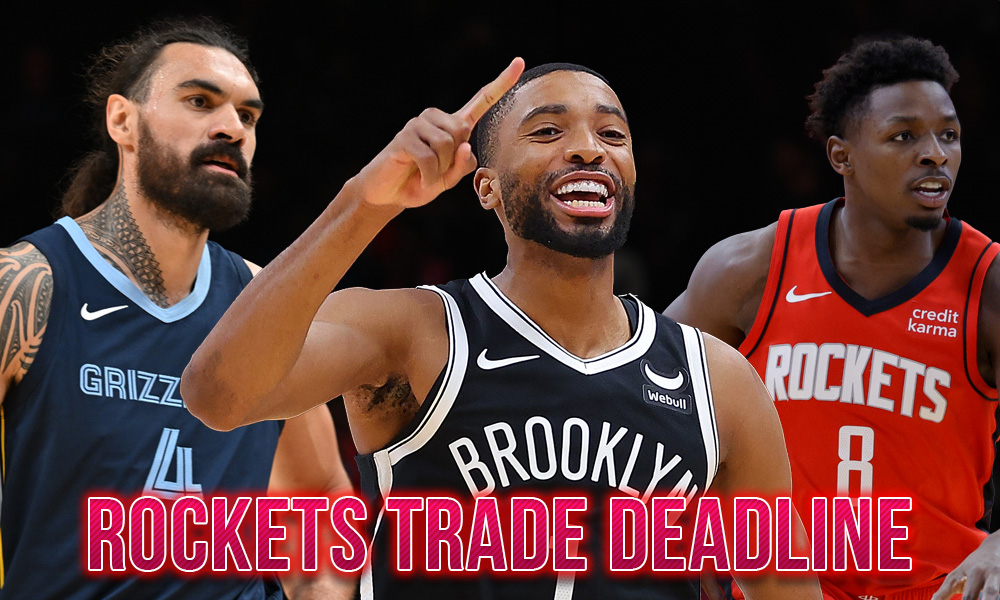
The Houston Rockets already made one deal, acquiring center Steven Adams from Memphis for a handful of second-round picks, but we still have several days left before this Thursday’s NBA Trade Deadline.
Are more deals on the way?
Rumors of interest in Mikal Bridges have swirled, with the Rockets holding precious (and unprotected) first-round picks from Brooklyn. They also could use some help inside this season, which Adams can not provide. Shooting is always in demand.
David Weiner joined Dave Hardisty on the ClutchFans podcast to discuss the Adams trade, its impact on the Rockets in 2024-25 and beyond, the Mikal Bridges rumors, the Brooklyn picks, other trade possibilities and options for Rafael Stone moving forward. Also discussed is the play of Houston’s core 6 prospects: Amen Thompson, Cam Whitmore, Alperen Sengun, Jabari Smith Jr., Tari Eason and Jalen Green.
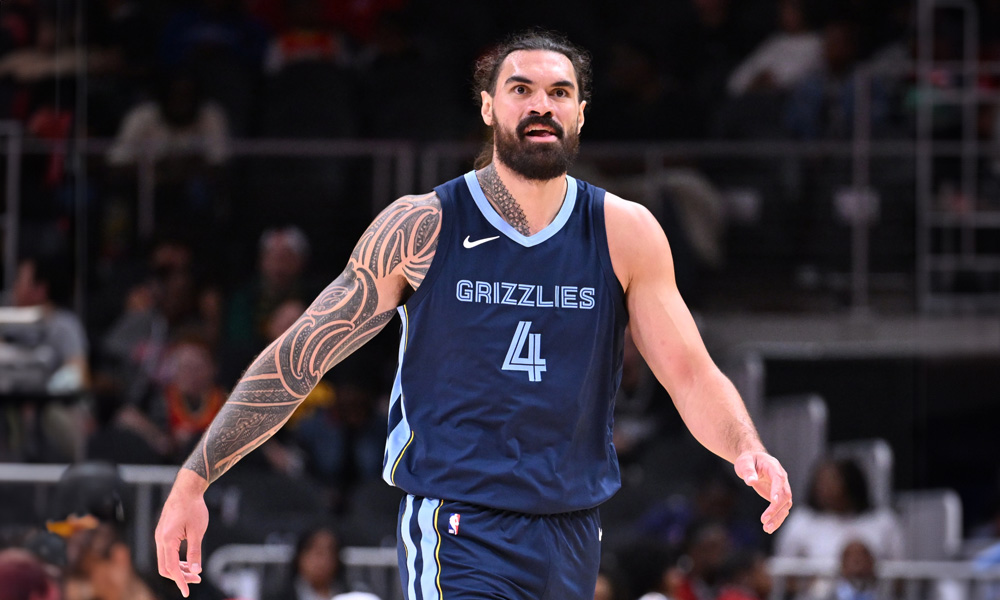
The Rockets made a surprise trade on Thursday, sending the contract of Victor Oladipo and three second-round picks to Memphis for center Steven Adams.
The deal came together quickly and the Rockets had a small window to get it done, hence why this trade was made with a week to go until the trade deadline.
The Price
When you consider that Memphis did this for cost savings primarily and that Adams would not play for any team in the league this season, the price seemed a little high to me. The Rockets gave up the OKC second-round pick this year, which is no big loss, but they also give up the better of Brooklyn’s or Golden State’s second-round pick this season. That’s a pretty good pick (likely in the late 30’s). They also give up the better of Houston’s or OKC’s second-round pick in 2025. If things go as planned for the Rockets, that pick should be in the 45-55 range.
But they didn’t sacrifice a first-round pick, which would have been brutal, and they were not going to use all those seconds this season. So it’s just a matter of opportunity cost — who else could they have gotten for this package?
My understanding is they (particularly Ime Udoka) are very high on Adams.
The Rockets also did this move for cap purposes as well. By moving out the Oladipo contract, which was expiring, and bringing in Adams’ deal, which is signed for $12.4M next season, the window for the Rockets to put together a trade package for a star player is extended out until the 2025 trade deadline. They continue to wait to see which players, if any, shake loose here and become available. They want flexible (see: expiring) contracts that they can combine with assets and this gives them another year to be in that position.
The Trade
It’s not often that the Rockets acquire a player I had not considered beforehand but that’s the case with Steven Adams. The Rockets sorely need a big with size that provides more traditional center strengths, making Clint Capela, Robert Williams, Nick Richards or Daniel Gafford potential candidates, but Adams was overlooked for a few reasons.
First, the 30-year old big man is out for the season after knee surgery cost him the entire 2023-24 campaign, so the Rockets won’t get any benefit from this trade this season. Secondly, Adams is not your traditional center either when it comes to rim protection.
But what Adams does do, he’s really good at and he has some of the same strengths of Brook Lopez, who the Rockets tried to sign in the offseason. Adams is quite possibly the strongest guy in the league and a legitimate 6-foot-11 with a 7-foot-5 wingspan. He’s an outstanding screen-setter, something that could really benefit the likes of Fred VanVleet, Amen Thompson and Jalen Green. He was also an elite rebounder last season, finishing 6th in the league in caroms at 11.5 a game despite playing just 27.0 minutes a contest.
After watching Jonas Valanciunas absolutely bully the Rockets inside on Wednesday, it should be apparent by now to everyone that this was a pretty big need.
In 2021-22, the Memphis Grizzlies finished #2 in the West at 56-26. Their top two players in Net Rating that season were Dillon Brooks (+11.0) and Adams (+8.3), key cogs in a defense that held opponents to 108.6 points per 100 possessions. They’re both now Houston Rockets.
So this adds another trusted vet to Ime Udoka’s rotation.
The question is will the 30-year old Adams return to form after the knee injury? Adams sprained the posterior cruciate ligament in his right knee a year ago, which cost him the end of that season and the playoffs. He tried rehabbing it and it never got better, so surgery became the option just as this season was kicking off.
I like to think the Rockets did their due diligence on that, despite the short time it took for this deal to come together, but that’s unclear.
If he does bounce back, then Udoka has a big man he can turn to reliably in situational matchups or on nights when the younger bigs struggle. He wouldn’t be Boban or even Jock Landale in that scenario — he’s going to play, so the frontcourt depth in 2024-25 should be better. In the end, they got a starting-caliber center who will have no problems coming off the bench, and that’s what they were looking for.
Houston Rockets
On the KPJ trade and future of the Rockets
Published
6 months agoon
October 18, 2023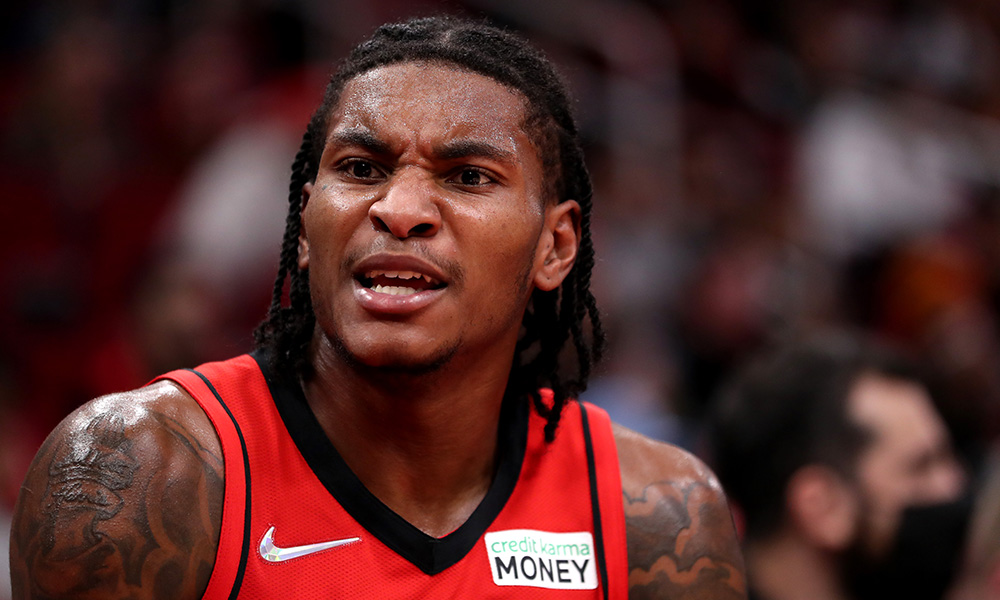
The Houston Rockets are back to being a professional NBA team once again.
The Rockets finally ended the Kevin Porter Jr. era on Tuesday, coughing up two second-round picks in order to unload his contract to the Oklahoma City Thunder, getting back the contract of Victor Oladipo and third-year forward Jeremiah Robinson-Earl. The move puts an end to a long investment and very rocky tenure with KPJ.
David Weiner joined Dave Hardisty on the ClutchFans podcast to discuss the Porter Jr. Experiment, the price paid to move him, Houston’s potential trade options moving forward, the new culture and the current state of the Rockets young core.
Houston Rockets
Heavy investment in Kevin Porter Jr raises serious questions about Rockets front office
Published
7 months agoon
September 20, 2023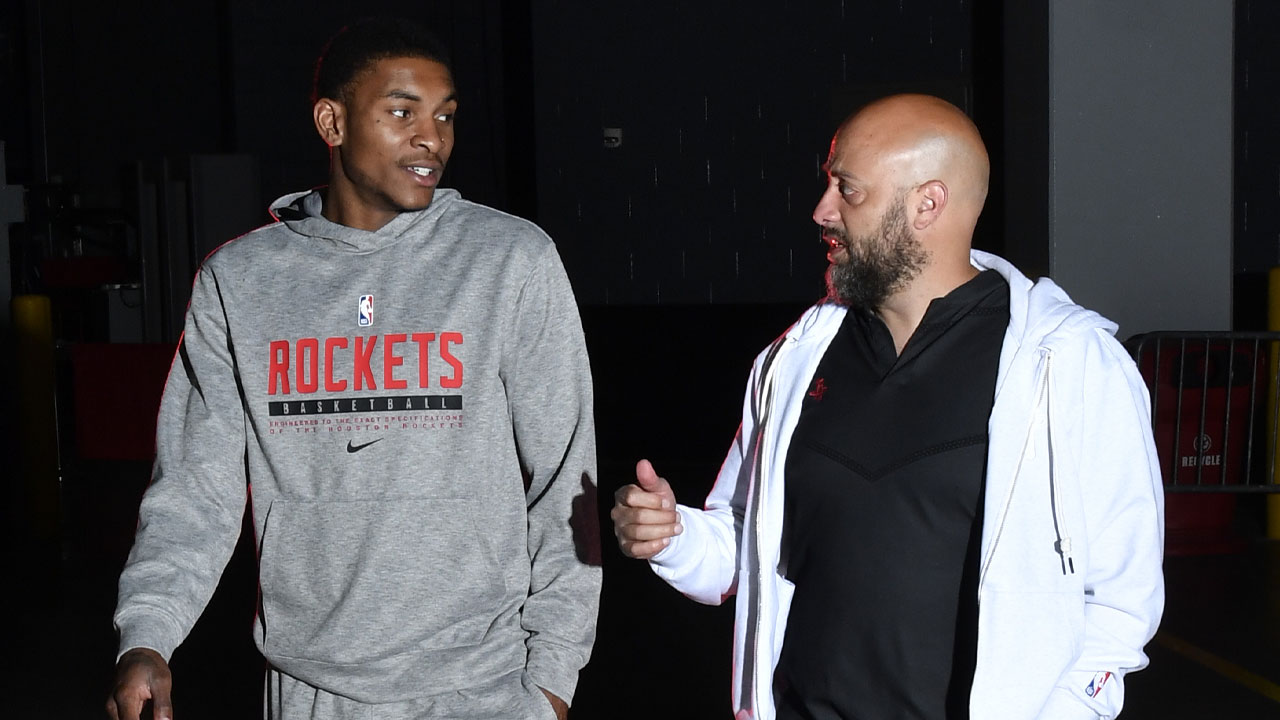
Soon-to-be-ex Rockets guard Kevin Porter Jr was arrested last week for allegedly assaulting his girlfriend, resulting in a fractured neck vertebra and a deep gash above her right eye after an attack at a hotel in New York. He allegedly woke her up by punching her repeatedly, strangled her and did not stop hitting her until she ran out of the hotel room screaming for help and covered in blood.
“This is a serious domestic violence case,” said assistant Manhattan district attorney Mirah Curzer.
First and foremost, I wish the victim healing. I don’t know what to say about the nightmare she went through. She and her family will forever be impacted. As for KPJ, if this is true, he doesn’t belong on the Rockets or in the NBA at all. He belongs in jail.
Secondly, this can’t be overlooked and just swept under the rug: Why did the Houston Rockets bank on and invest so heavily in this guy?
Kevin Porter Jr. being accused of crimes of this severity should not be shocking – at all. Before he even came to the Rockets, he had a long list of serious problems. He was suspended multiple times in high school. In 2019, he had a “conduct issue” significant enough that USC suspended the 5-star recruit indefinitely. He fell to the end of the first round of the 2019 NBA Draft because of his behavior liability. He was accused of punching a woman in the face in Cleveland. He also had a gun and marijuana charge later dismissed after getting into a car crash. He went into a tirade and got into a nasty confrontation with both the Cleveland coach and GM, resulting in the Cavs severing ties immediately and dumping him to the Rockets for nothing.
You could make the argument that initially giving Porter Jr. a second chance in Houston was praiseworthy, but the Rockets experienced KPJ’s anger management and immaturity issues firsthand on several occasions.
Former Rocket Austin Rivers said this week that this isn’t the first, second or even seventh issue with Porter Jr. and that Rockets “higher-ups” confided in him that they had no idea how to handle him.
“I remember talking to guys in the Houston Rockets organization, higher-ups, [and] they were having issues then,” said Rivers. “They were like, ‘We don’t know what to do with him.’ And that’s when he just got there from Cleveland!”
Porter Jr. was routinely a nightmare for Rockets coaches to deal with. On several occasions, he confronted and cussed out members of the coaching staff, saying they didn’t have the “credentials”, per source, a reference to the fact that him playing heavy minutes at point guard was a decision they did not control.
Once at a night out, Porter Jr. had a disagreement with a DJ over music choice and he snapped, smashing the DJ’s laptop to the floor. He needed to be restrained and removed. Rockets personnel and several of Porter’s teammates witnessed the incident.
Curzer also dropped a bombshell at the arraignment in saying that Porter Jr. has a history of abusing his girlfriend, who he had only been dating since early last year, his second season with the Rockets. Curzer specifically cited an incident in which KPJ allegedly rammed his car into hers.
There were dozens of maturity issues visible on the court to anyone paying attention. He refused to check out of games. He got into an argument on the bench with assistant Lionel Hollins. On numerous occasions, he would visibly shut down when he wasn’t passed the ball. I invite you to watch this video from a game against Memphis on March 20, 2022. Just listen to the Grizzlies broadcasters, particularly starting at the 1:40 mark, talk about what they are witnessing here:
Privately, people around the league would say they were baffled by the Rockets continued fascination with Porter Jr. Nobody could understand it.
That fascination starts with Rockets general manager Rafael Stone, who by every account over the last two years was the driving force behind the investment in Porter Jr. It has been no secret. Trading for him in January 2021 was seen by some with the team as his “Harden acquisition”, code for a signature move that makes an executive’s career, much in the way landing James Harden did for Daryl Morey in 2012.
For example, former Rockets head coach Stephen Silas never considered Porter Jr. to be a point guard, per sources — playing him there was a Stone mandate because the GM believed that is where his future lied.
John Wall also told us as much publicly when he explained the phone call he got from Silas about coming off the bench. He said Silas told him “This is what the GM wants,” adding again that Silas said, “Man, you don’t deserve that. You should be the starter. This is just what they want to do.” Wall was upset because he believed KPJ should have to earn the spot.
“I have a hard time finding anybody outside of the Rockets front office that believes that Kevin Porter Jr. is a starting point guard in the NBA,” said ESPN reporter Tim MacMahon in December.
There were plenty of warning signs about KPJ to the public too.
After Porter Jr. got into a heated argument in which KPJ “physically shoved” Rockets assistant coach John Lucas and quit on the team in the middle of a game against Denver in January of 2022, leaving the arena at halftime, Sports Illustrated’s Chris Mannix famously wrote that the Rockets should “Cut Porter Jr. Waive him. Release him. Whatever. Eat what’s left of the $1.8 million he’s owed this season and the $3.2 million he’s got next and move on.” It became a source of mockery for Porter Jr’s fans, a line they would bring up after each game he hit a few threes or handed out some assists.
In February of this year, ESPN’s Jonathan Givony, one of the most connected reporters in the league, flat out warned us that he was hearing awful things about the Rockets culture and locker room. He was blunt in what the Rockets needed to do — waive Kevin Porter Jr. outright and bring in a new coach and GM.
“Just cut him. That’s it,” said Givony of Porter Jr. “And you’re sending a signal to the league that we’re going to do things differently from here on out.”
“When you talk to people around the NBA about Houston, you just don’t hear good things about their culture, about that locker room. You talk to people that are on that team, and they are like, ‘We are a mess’,” said Givony. “Do people want to work with this organization? But you can change that fairly quickly if you come in, get rid of the bad apples and you change the coaching staff, and all of a sudden, you’re Houston. It’s the third-biggest city in America. There’s a history here of you actually being good.”
Porter came to the Rockets for “free” (in exchange for a top-55 protected second-round pick, which was designed not to convey), but he proved far from it as the Rockets continued to pour investment into him. Over the last 2-3 seasons, no Rockets player got more developmental capital than Porter Jr. – not Jalen Green, not Alperen Sengun, not Jabari Smith Jr. The Fertittas paid John Wall $85+ million over two years to sit at home so the team could groom Porter Jr. to be their future point guard.
Then they doubled down. With restricted free agency on the horizon and a seemingly non-existent market for KPJ’s services, the Rockets gave Porter Jr. an extension a year sooner – a contract that was presented as a four-year, $82.5 million deal. The deal was more team-friendly than that, putting team options in it after years 1 and 3. Going from the potential disaster that was initially reported to a deal they could escape after one season felt like a “win”, but the biggest question was why they wanted him long-term at all. The unprecedented nature of a contract that size with that kind of club control clearly showed the Rockets knew there was unique and significant risk here.
After KPJ signed the extension, The Athletic’s Kelly Iko summarized the Rockets view of Porter Jr. – “As has been [their] stance for months, the Rockets have maintained the notion that Porter is a priority and is considered a huge part of their core, along with Green and Jabari Smith Jr.”
The Rockets actions to kick off the 2022-23 season showed exactly that – that he was a priority. They benched Sengun to start the season, in large part to give KPJ a “lob threat” and defender in the starting lineup. They gave him the superstar “Harden Locker”. They introduced him last in the starting lineups. They treated him as the star and empowered him to be the self-proclaimed “Head Honcho” of Clutch City.
But the extension proved unwise and foolish. Porter Jr. never even made it to the first year of it. With over $80 million on the line, he snapped again. The Rockets signed him to one of the team-friendliest deals ever and still managed to both overcommit and overpay as Stone now scrambles to attach real assets to it to get another team to take it off his books.
Is it fair to question the judgment of the Rockets front office? Absolutely and without question. Whether you look at their ability to value character, evaluate risk, scout basketball, build culture, manage assets or allocate development resources, they failed at every level here. Why didn’t they act sooner? Why did they double down? Why didn’t they hold him accountable? Why did everybody in the league see it but them?
“We value the player and the person that [Kevin Porter Jr.] is becoming and are eager to invest in him and his journey,” said Stone after rewarding him with the extension less than a year ago.
The question you have to ask yourself now is, with all they knew and witnessed about Porter Jr. both on and off the court — why were they eager at all?
Houston Rockets
Three predictions for an important Rockets offseason
The 2023 offseason is critical for the Houston Rockets and here’s what we think will happen
Published
1 year agoon
April 6, 2023
We have almost arrived to the oasis.
For over two years, the “2023 Offseason” has been circled on the calendar as the turning point, the time when the Houston Rockets will switch gears and make winning a priority. With potentially $60 million in cap room and a top draft pick coming, this is the moment of truth that Rafael Stone and the Rockets front office pitched to the Fertittas when the rebuild began.
Does that mean the Rockets are going to magically start winning next season? Not necessarily. But it does mean we won’t see Daishen Nix run the point for 36 minutes in the name of player development. They want to win.
It’s very tough to know what will happen this offseason, given the unknown variables. The Rockets could land a top-two pick, which would bring them Victor Wembanyama or Scoot Henderson, radically boosting their future. James Harden could opt to return, which also significantly boosts their near-term prospects.
But regardless of whether or not luck presents a “lifeboat” (Harden, Wemby, Scoot), here are some things I believe will happen.
Also, if you have been joining us in RocketsWatch all season, first of all, thank you! We greatly appreciate all the fan support this season. But if you’ve stuck around through a tough season, you know that none of this will come as a surprise. I have been talking about these predictions since January.
1. Rockets, Stephen Silas Will Part Ways
Stephen Silas is going to be let go this offseason.
The original plan was for Silas to coach this season and start the next, getting a shot once the Rockets were making winning their top priority. But the bar was low this season and he still fell short. There were several times where the team needed a stronger hand and it wasn’t there. The roster wasn’t built to win, but there is no argument to be made that coaching did anything to enhance the situation.
It’s important to point out that Silas got a raw deal, coming to Houston under different circumstances expecting to coach a veteran team. But this is the hand that was dealt and the Rockets have to play it. Silas may be a fine coach, but he’s not the right coach for this team and that’s all that matters at this stage.
Ownership was ready to move on by midseason, but a variety of factors have led to him finishing the year. But this is going to be it. They sorely need fresh eyes and a different voice.
Confidence Level: 100%
2. The Kevin Porter Jr. Starting Point Guard Experiment Will End
The Rockets got Kevin Porter Jr. for free from the Cleveland Cavaliers in 2021, but he’s been anything but since.
Houston paid nearly $100 million to John Wall to stay at home so they could groom KPJ as their future point guard. They also signed Porter Jr to a team-friendly four-year deal despite the fact that a much more team-friendly restricted free agency was on deck.
Porter Jr. has gotten better and more comfortable at the lead guard spot in two-plus seasons, which could bode well for his future here, but it’s not near enough. He lacks ability to make advanced reads, which is one of the reasons the Rockets are dead last in corner three-point attempts. His tendency is to isolate, which is his strength, and that can create a lot of selfish basketball. In essence, the Rockets have been starting a pair of shooting guards.
The Rockets love them some KPJ, particularly Stone, so I’m not saying he’s done here. He could thrive in an alternate role, if he embraces it. But the Rockets want to make a leap next season, the first year they are on the hook to Oklahoma City for their first-round pick from the costly Russell Westbrook trade. You’re probably not going to make a bigger jump than by improving the on-court leader spot.
Confidence Level: 80%
3. Alperen Şengün Will Be Shopped
You either believe Alperen Sengun is the next Nikola Jokic or he’s a defensive liability that is too much trouble to build around. There doesn’t seem to be much in between.
Sengun is incredibly gifted offensively and is only 20 years old, so it’s very early. This is also the biggest offseason of his young career, where he won’t be preparing for EuroBasket and can specifically train for the NBA.
There is no evidence at all they are looking to trade him. I’m very much going rogue with this prediction. But consider:
1. Internally he has been viewed as possibly the worst pick-and-roll defensive big in the league.
2. They started Bruno Fernando over him to open the season.
3. They rarely run the offense through him (“ŞenHub”).
4. The Rockets are not well-positioned with future draft picks to trade and likely need to move a good young player if they’re looking at any significant deals.
5. They believe bringing in a center is a high priority (though that could be as a backup to Sengun).
To be clear, I’m not predicting Sengun will be dumped but rather we will hear his name floated in rumors. A lot could change — a new coach could see Alpi as key to the future, for example — but right now, given all the factors listed above, I would be surprised if Sengun is the centerpiece of this rebuild. I think he’s more likely the trade piece.
https://twitter.com/RocketsWatch/status/1627944952498950147?s=20
Confidence Level: 60%

